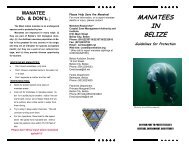The Placencia Lagoon - Coastal Zone Management Authority and ...
The Placencia Lagoon - Coastal Zone Management Authority and ...
The Placencia Lagoon - Coastal Zone Management Authority and ...
You also want an ePaper? Increase the reach of your titles
YUMPU automatically turns print PDFs into web optimized ePapers that Google loves.
Salinity<br />
<strong>The</strong> salinity of the Southern Shelf <strong>Lagoon</strong> is affected on a seasonal basis by the<br />
precipitation <strong>and</strong> river discharge in the southern province. <strong>The</strong> salinity of the Southern<br />
Shelf <strong>Lagoon</strong> fluctuates range between 33 to 35 parts per thous<strong>and</strong> (Gibson et al., 1993).<br />
<strong>The</strong> Importance of the <strong>Placencia</strong> <strong>Lagoon</strong><br />
Like most tropical <strong>and</strong> subtropical estuarine systems, the <strong>Placencia</strong> <strong>Lagoon</strong> has<br />
ecological <strong>and</strong> environmental significance. <strong>The</strong> lagoon per se has a diverse amount of<br />
planktonic life that makes it an ideal nursery ground for a myriad of marine <strong>and</strong> estuarine<br />
organisms. Many of the fish that are caught for food or fun in the higher parts of the<br />
estuary or within the Belize Barrier Reef complex depend on the <strong>Placencia</strong> <strong>Lagoon</strong> for<br />
portions of their life cycles. Furthermore, the <strong>Placencia</strong> <strong>Lagoon</strong> provides adequate<br />
ecological <strong>and</strong> environmental conditions for the endangered <strong>and</strong> threatened West Indian<br />
Manatee (Trichechus manatus). <strong>The</strong> lower portion of the lagoon is relatively shallow<br />
with extensive beds of seagrass Thalassia testudinum that these creatures feed on. In<br />
close proximity to the lagoon are the mouths of several streams that are adequate source<br />
of freshwater for the manatees to drink. <strong>The</strong> inner portions of the <strong>Placencia</strong> <strong>Lagoon</strong> have<br />
areas that are completely protected from wind <strong>and</strong> wave activity that offer a safe <strong>and</strong><br />
tranquil resting place for adult manatees <strong>and</strong> their calves.<br />
During the surveys, dolphins were sighted feeding in the middle <strong>and</strong> lower portions of the<br />
<strong>Placencia</strong> <strong>Lagoon</strong> (Plate 1). Fishers from Seine Bight Village confirmed that dolphins<br />
are sighted regularly throughout the year in the lagoon (pers. com., Javier Maritinez).<br />
Morelet’s crocodiles (Crocodylus moreletii) are also a threatened species that have been<br />
sighted in various parts of the <strong>Placencia</strong> <strong>Lagoon</strong> system. Platt et al. (1997) found no<br />
evidence of nesting activity in the <strong>Placencia</strong> <strong>Lagoon</strong> however, spoil banks in the Maya<br />
Beach area are considered potential nesting habitats. Grimshaw (2000) reported that the<br />
Morelet’s crocodiles use the habitats in the lower reaches of the <strong>Placencia</strong> <strong>Lagoon</strong> for<br />
nesting sites.<br />
<strong>The</strong> vegetation fringing the lagoon supports nesting sites for several marine birds. Quite<br />
frequently pelicans, gulls <strong>and</strong> bobbies are seen feeding in the lagoon <strong>and</strong> roosting on the<br />
natural vegetation. In addition to this, the marshl<strong>and</strong>s surrounding the <strong>Placencia</strong> <strong>Lagoon</strong><br />
serve as natural filters for sediment <strong>and</strong> pollutants. ESTAP (2000) report that the Mango<br />
Creek Special Development Area Development Plan approved in 1997, identified the<br />
need to protect the mangrove wetl<strong>and</strong>s that surround the <strong>Placencia</strong> <strong>Lagoon</strong>. <strong>The</strong> intention<br />
is to ensure that water quality in the lagoon, together with manatee <strong>and</strong> other wildlife, is<br />
not negatively affected by inappropriate development. Some residents from <strong>Placencia</strong> <strong>and</strong><br />
Seine Bight in conjunction with organizations such as BTIA <strong>and</strong> Friends of Nature<br />
express concern about the fate of the <strong>Placencia</strong> <strong>Lagoon</strong>.<br />
11



